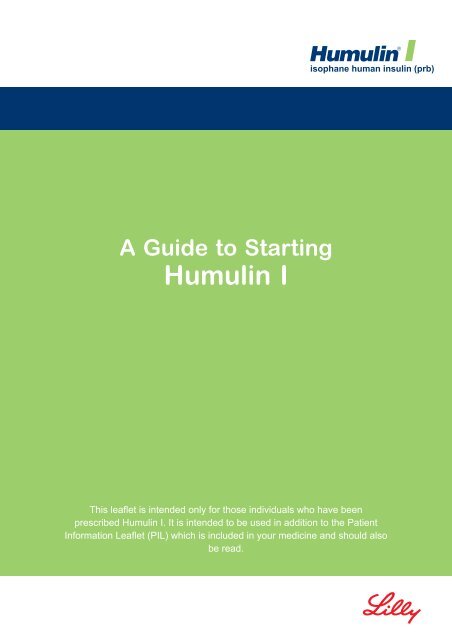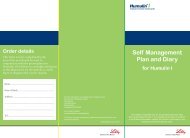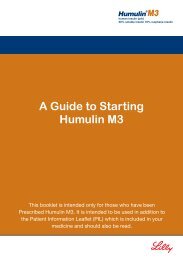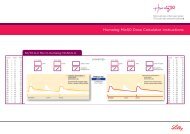Humulin I - LillyPro
Humulin I - LillyPro
Humulin I - LillyPro
- No tags were found...
You also want an ePaper? Increase the reach of your titles
YUMPU automatically turns print PDFs into web optimized ePapers that Google loves.
Contents• What should I have received from the Pharmacist?• Why have I been given this booklet?• What is <strong>Humulin</strong> I and how does it work?• When do I take my insulin?• Who decides how much insulin I need?• When do I check my blood glucose levels?• Instructions for self-adjustment of my insulin• How do I inject my insulin?• Preparing your injection• What if I forget an injection?• What is a hypo and why does it happen?• How do I deal with hypos?• What should I do if I feel unwell?• When should my treatment be reviewed?2
What should I have received fromthe Pharmacist?KwikPenCartridgeVialYou have been prescibed an insulin called <strong>Humulin</strong> I.Ensure that your medicine has <strong>Humulin</strong> I on thepackaging, as shown aboveYour insulin should be - please tick• 3ml <strong>Humulin</strong> I cartridge for use in a durablepen device e.g The HumaPen Savvio• 3ml <strong>Humulin</strong> I KwikPen (prefilled)• 10ml <strong>Humulin</strong> I vial (for use with a syringe)❑❑❑3
What is <strong>Humulin</strong> I andhow does it work?<strong>Humulin</strong> I is an intermediate acting insulin.<strong>Humulin</strong> I reduces your blood glucose levels.This is how <strong>Humulin</strong> I works over a 24 hour period.24 hour action profileInsulin ActivityThis profile may vary with factors such as size of dose, site of injection,temperature and physical activity.5
When do I take my insulin?You may need to take <strong>Humulin</strong> I in the morning(before breakfast) and/or in the evening (either beforeyour evening meal or before bed).Your healthcare professional will advise you howoften you need to take your insulin.How much will I need?BeforeBreakfastBeforeEvening MealBefore BedDoseThis is your starting dose and may change.Your dose may need to be increased or decreasedbased on your blood glucose readings.6
Who decides how much insulinI will need?Your insulin dose will be adjusted by you and/or yourhealthcare professional according to the results ofblood glucose tests you do.Do not worry if it takes a while before you reachyour target blood glucose levels and you need moreinsulin. Each person is different and what is importantis that it is the right amount for you.Why do I need to test my blood glucose levels?It is important that you are aware of your own bloodglucose levels in order for you to take the appropriateaction, for example, adjusting your insulin dose.There are a number of reasons why you may need toadjust your insulin dose, including:• High blood glucose levels (hyperglycaemia)• Low blood glucose levels (hypoglycaemia)• Stress/illness7
When do I check myblood glucose levels?It is likely that you will need to check your blood glucoselevels first thing in the morning before breakfast (fastingblood glucose).However your healthcare professional will discuss with youhow often and when to test. This may change during thecourse of your diabetes.What should your blood glucose levels be?Please complete:Your before breakfastYour before lunchYour evening mealYour before bed time............... mmol/L............... mmol/L............... mmol/L............... mmol/LIt may take a while to achieve these levels and you mayrequire an increase of your insulin.Do I need to adjust my insulin and how do I do it?You might not need to adjust your insulin. If you do needto adjust your insulin your healthcare professional will talkyou through the next few steps.You may feel apprehensive at first, but it is important thatyou take control to make it work for you.8
Instructions for self-adjustmentof my insulinWhen testing your blood glucose, if you haveconsistently high readings for more than three daysat any testing point, then you will need to adjust yourinsulin.Your healthcare professional will explain to you how toadjust your insulin and will complete the following tablefor your needs.Night-time <strong>Humulin</strong> IAdjust units of insulinNight-time <strong>Humulin</strong> I onlyFasting (before breakfast) mmol/Labove ............. below .............Morning <strong>Humulin</strong> I onlyBefore evening meal mmol/LMorning <strong>Humulin</strong> Iabove ............. below .............Adjust units of insulin9
Twice daily<strong>Humulin</strong> ITwice daily <strong>Humulin</strong> IFasting (before breakfast)mmol/LabovebelowBefore evening mealmmol/Labovebelow....................................................Adjust unitsof insulinadjust evening doseadjust morning doseDose reduction is recommended if any results areconsistently less than 4 mmol/L (hypo) at any time.10
How do I inject my insulin?Your healthcare professional will explain how toinject your insulin. Injection is usually via approvedpen devices or insulin syringe.Where do I inject?Your insulin can be injected in the places shownbelow. The site of the injection should be rotatedwithin the chosen area to prevent complicationsdeveloping at your injection site and aid insulinabsorption. Check with your healthcare professionalwhich are the most suitable injection sites.11
Preparing your injectionIt is important that before you inject your insulin yourotate it between the palms of the hands ten times andinvert it through 180° ten times immediately before use.This is to ensure the insulin is mixed properly. It shouldappear uniformly cloudy or milky.The image above is a KwikPen, if you have beenprescribed <strong>Humulin</strong> I in a cartridge you should load thecartridge into the pen device and then mix similarly tothat shown above.12
What if I forget an injection?Forgetting your insulin is rarely an emergencysituation. Seek advice from your diabetes team.The advice will vary depending on when you haverealised you have forgotten to take your insulinWhat if I cannot remember if I had my insulin?If you are in any doubt, do not take your insulin again.In both cases your blood glucose may run a littlehigher after the injection you have forgotten.Do not worry.It is very important that youknow the name of your pen device,your insulin and the nameof your blood glucose meterMy insulin is:My pen is:My blood glucose meter is:13
What is a “hypo” and why does it happen?A blood glucose reading of 4mmol/L and under ishypoglycaemia (a “hypo”). A hypo occurs when bloodglucose falls too low. People feel different thingswhen a hypo is starting, you may also find some ofyour hypos feel different from others.A hypo can happen for a number of reasons:• If you’ve missed a meal or had one later than usual• If you’ve not had enough food or eaten less foodthan normal• If you’ve had more insulin than necessary• If you’ve been more active than usual• If you’ve been drinking alcohol• If you’ve experienced extremes in temperature,either hot or coldIf your diabetes is well controlled occasional hyposare a normal part of life for people with diabetes, butthey shouldn’t take over your life. If you are havingfrequent hypos, speak with your diabetes team.14
Hypos begin quickly, but there are usually warningsigns. Symptoms can vary from person to person,but may include the following:• Sweating• Thumping heart• Looking pale• Weakness or tiredness• Pins and needles sensation• Dizziness/ feeling tipsy, drunk• Disturbed vision• Mild confusion• Slurred speech• Hunger• Aggression or altered behaviour• HeadacheIf hypoglycaemia isn’t corrected it can lead to moreserious conditions such as loss of consciousness.15
How do I deal with hypos?If you experience a hypo, you should deal with it bytaking 15-20g of quick acting carbohydrate such as:• 5 - 7 Dextrosol ® tablets or,• 90-120ml of original Lucozade ® or,• 150-200ml of pure fruit juice such as orange juiceYour healthcare professional may also advise you ofquick acting carbohydrate such as:It is advisable to re-check your blood glucose levelafter taking carbohydrate to ensure your bloodglucose levels are rising.16
If you are not about to eat a meal, ensure you eat10-20 grams of slow acting carbohydrate, to maintainyour blood glucose levels until you next eat.This can be:• half a sandwich• fruit• a small bowl of cereal• biscuits and milkYour healthcare professional may also advise you ofslow acting carbohydrate such as:The exact quantity will vary from person to person.Remember to carry your identity card and glucosetablets with you in case of an emergency.If you have regular hypos consider adjusting yourinsulin and/or contacting your nurse or doctor.17
What should I do if I feel unwell?A number of common illnesses can cause your bloodglucose to rise. When you are unwell you may notwant to eat or take your insulin treatment as normal,but it is important to follow these basic rules:1. Keep on taking your insulinHowever ill you feel and however little food youare eating, according to your blood glucose levelsyou may still need insulin. Sometimes in thesecircumstances you need more than your usual dose.Ask your healthcare professional for specific adviceon what action to take when you are ill.2. Monitor your blood glucoseMonitor your blood glucose. Test at least 4 timesdaily as your blood glucose levels will indicatewhether you require extra insulin doses.3. Take carbohydrates in liquid formTake unsweetened fluids if your blood glucose ishigh. If you still do not feel like eating as your bloodglucose returns to normal then substitute food withsweetened fruit juices or drinks that contain glucose.18
When should my treatment be reviewed?If you have type 2 diabetes then we recommend thatyou contact your healthcare professional when you havereached a total of............. units.This is so your treatment can be discussed with you andyou may also be advised to monitor blood glucose testsat different times of the day or night.You should contact your healthcare professional earlierif you have any questions or are unsure what to do withyour insulin.19
If you have type 2 diabetes it is important to note thatdiabetes is a progressive condition. Over time yourpancreas makes less and less insulin. In the future youmay need mealtime insulin. Mealtime insulin is takenwith food. Your current basal insulin covers your bloodglucose (sugar) levels between meals and at night whilemealtime insulin can help you control the rise in yourlevels when you eat. It requires you to add injections andpossibly increase the number of blood glucose testseach day.Your management plan will be individually developed tomeet your needs and lifestyle.20
Notes Page21
Notes Page22
Notes Page23
Side effects should be reported.This includes any possible side effects not listed inthe package leaflet. If you experience side effects talkto your doctor or other healthcare professional.Any side effects from your medication can be reported atwww.mhra.gov.uk/yellowcard.Side effects and product complaints can also bereported to Lilly: please call Lilly UK on 01256 315 000.By reporting side effects you can help provide moreinformation on the safety of medicines.Eli Lilly & CompanyPriestley RoadBasingstokeRG24 9NL01256 315 000www.lillydiabetes.co.uk/patientsThis booklet has been developed with the Diabetes Specialist Nurses in Sheffield, Middlesbroughand Salford Royal Foundation Trusts and Diabetes Specialist Nurses from Dumfries & GallowayRoyal Infirmary. The booklet has been reviewed for medical accuracy and printed by lilly.UKHML00004c(1) March 2014











![Humalog Mix50 (50% insulin lispro [rDNA origin] injection ... - LillyPro](https://img.yumpu.com/44269187/1/184x260/humalog-mix50-50-insulin-lispro-rdna-origin-injection-lillypro.jpg?quality=85)
![Humalog Mix25 (25% insulin lispro [rDNA origin] injection 75 ...](https://img.yumpu.com/35487335/1/184x260/humalog-mix25-25-insulin-lispro-rdna-origin-injection-75-.jpg?quality=85)



